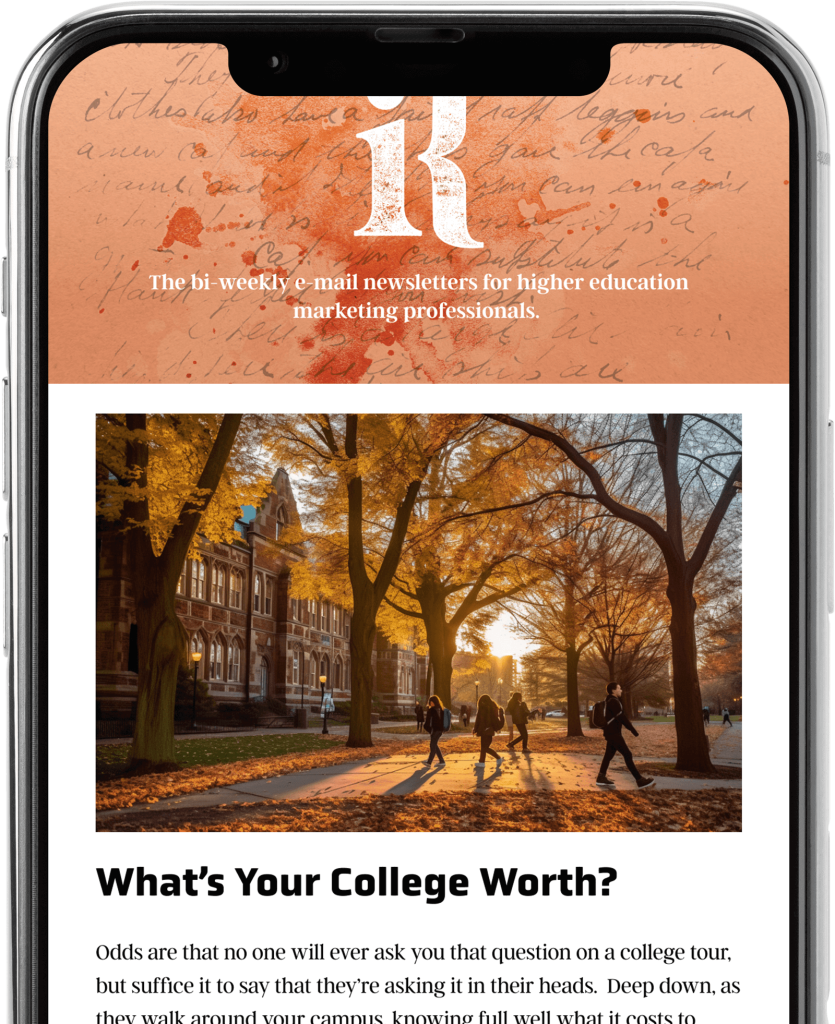Higher Education Marketing
The Differentiated Institution

The 3 hurdles framework begins with differentiation and challenges us to think about whether or not something is truly unique. The other two hurdles challenge us to question whether people will care about how we’re different in this way and, if they do, if we can maintain that position of differentiation. At one point, for example, only a few schools offered online learning. Fast forward to today when every school can offering virtual learning and most do. It may have been a differentiator at some point, but not for long.
Differentiation is at the heart of what every institution must consider seriously in order to thrive. True, many can (and will) survive and exist without taking this concept seriously, but it doesn’t mean the institution will reach its full potential. We continually ask our students to reach for their full potential. Shouldn’t we hold ourselves to that same standard?
Differentiation is a thread that runs through most marketing strategies and activities and we would do well to challenge ourselves to that standard in a myriad of ways. It’s how we avoid being simply dismissed as a “small college,” “state school,” “commuter school,” or “liberal arts school.” It’s how we create and maintain our own identity—our calling card. It’s how we stop someone, hopefully a student who would be perfect for us, and almost magnetically draw them to consider our institution.
It should be apparent in the design of our websites, the copy we use to talk about ourselves, and in the imagery we use to project who we are—there’s something unique about us. The words we use to talk about ourselves shouldn’t sound like every other school doing the same thing. The stories we tell on Instagram should feel unique and unlike anything that prospect has seen before. The features of our campus that are unique to us should be on display. The photos we feature should not feel as if they were purchased in bulk on a stock image website.
We do all of this, strategically, because in the words of famed strategy professor Michael Porter, “strategy is about being different.” We do all of this because we want to stand out and avoid being lumped into a group from which we are actually distinguished. We do all of this because, well, we are different.
Discovering how we are different can be done by examining the institution according to various comparative dimensions. There are any number of factors that we can use to compare our institution to another or, perhaps more importantly, how others will compare us to our peers or competitors. Here are a handful of areas used to distinguish your institution from another.
Academic Programs: Prospective students may look into the range and quality of programs offered, including majors, minors, and specializations and consider whether the college offers the specific program or field of study in which they’re interested.
Faculty: Research the qualifications, expertise, and reputation of the faculty members. A strong faculty can greatly impact the quality of education and opportunities available to students.
Class Sizes and Student-Faculty Ratio: Prospective students may consider the average class size and the ratio of students to faculty members. Smaller class sizes often allow for more personalized attention and interaction with professors.
Campus Culture and Environment: Visitors will explore the campus atmosphere, student demographics, and extracurricular activities available and consider whether the campus culture aligns with their interests and values.
Location: Interested prospects will evaluate the location of the college in terms of proximity to home, urban versus rural setting, climate, and available amenities and think about whether they prefer a bustling city environment or a quieter campus setting.
Facilities and Resources: They will likely assess the quality of facilities such as libraries, laboratories, dormitories, recreational areas, and student support services. Adequate resources can enhance the overall college experience.
Reputation and Rankings: Prospectives students will take into account the college’s reputation and rankings, both overall and in specific fields of study. While rankings are not the sole indicator of quality, they can provide valuable insights.
Cost and Financial Aid: Certainly prospects will consider the tuition fees, cost of living, and availability of financial aid and scholarships and evaluate whether the college offers opportunities for work-study programs or internships to help offset expenses.
Career Services and Alumni Network: The career services offered by the college, including internship placements, job fairs, and networking opportunities will be an important consideration. A strong alumni network can also provide valuable connections and support after a student graduates.
Accreditation and Academic Support: Prospective students will likely want to ensure that the college is accredited by recognized accrediting bodies and evaluate the availability of academic support services such as tutoring, advising, and counseling.
Global Opportunities: For those interested in studying abroad or participating in international programs the college’s offerings in terms of exchange programs, international partnerships, and opportunities for global experiences will likely be considered.
Retention and Graduation Rates: The college’s retention and graduation rates, as well as the success of graduates in terms of employment and further education will be a factor in evaluating the overall effectiveness of the college in supporting student success.
These areas of differentiation are just a few examples and each institution should consider hundreds of factors that represent true areas of distinction. Once a variety of factors are identified, further differentiation can be created by grouping or stacking multiple areas of differentiation to create compelling differentiation themes that resonate with prospective students. Here are some examples of how three or four areas of differentiation can be combined to build themes of differentiation.
Innovation Hub:
- Academic Programs: Cutting-edge majors and interdisciplinary studies.
- Faculty Expertise: Renowned professors leading research in emerging fields.
- Facilities and Resources: State-of-the-art labs and innovation centers.
- Career Services and Alumni Network: Strong connections to industry leaders and entrepreneurial support.
Global Engagement Campus:
- Location: Strategic location in a cosmopolitan city or international hub.
- Global Opportunities: Extensive study abroad programs and diverse student body.
- Faculty and Research: Internationally recognized faculty with global research collaborations.
- Alumni Network: Wide-reaching alumni network spanning across continents.
Community-Centered College:
- Campus Culture and Environment: Tight-knit community with a focus on inclusivity and diversity.
- Facilities and Resources: Modern facilities designed for collaboration and social engagement.
- Career Services and Academic Support: Personalized career guidance and academic advising.
- Location: Quaint college town offering a supportive environment for student growth.
Sustainability-Focused Institution:
- Academic Programs: Environmental science majors and sustainability-focused curriculum.
- Facilities and Resources: LEED-certified buildings and green initiatives on campus.
- Global Opportunities: Internship programs with leading environmental organizations worldwide.
- Research and Innovation: Cutting-edge research on renewable energy and sustainable development.
Tech-Savvy University:
- Academic Programs: Specialized majors in computer science, engineering, and information technology.
- Facilities and Resources: State-of-the-art labs equipped with the latest technology.
- Faculty Expertise: Industry-experienced professors at the forefront of technological advancements.
- Career Services and Internship Opportunities: Strong industry partnerships leading to internship and job placements at top tech companies.
Arts and Culture Hub:
- Academic Programs: Diverse range of arts majors and creative disciplines.
- Faculty and Research: Renowned artists and scholars leading innovative research in the arts.
- Campus Culture and Environment: Vibrant arts scene with galleries, theaters, and performance spaces.
- Location: Situated in a culturally rich city known for its arts and entertainment industry.
These examples demonstrate how you might strategically combine multiple areas of differentiation to create compelling themes that appeal to specific segments of prospective students. By emphasizing these themes in marketing materials, campus tours, and outreach efforts, you can effectively communicate their unique value proposition and attract students who align with their core strengths and values.
Like what you're reading?
Subscribe to our newsletter to get the latest insights in Higher Education and thought leadership.


